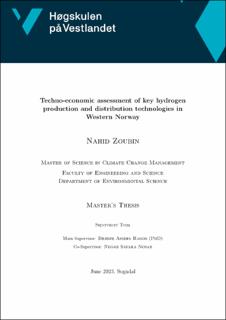| dc.description.abstract | The industry and transportation sectors are the main sources of CO2 emissions in Norway. These sectors are difficult to be decarbonized through direct electrification, mainly due to technological limitations, and pose major challenge towards the 2050 energy and climate targets. In line with the enhanced climate goal of the Norwegian government to reduce GHG emissions by 55% in 2030 and 95% in 2050 compared to 1990 level, there is a growing political interest for deep decarbonisation of industry and transportation using hydrogen. Towards achieving this goal, it is important to identify the least-cost hydrogen production and distribution methods in Norway.
Currently, hydrogen is being produced in Norway mainly from natural gas with steam reforming technology. But potentially hydrogen could be produced from several renewable energy sources. It is important to compare various hydrogen production and distribution hydrogen technologies to identify the least-cost solutions and the key parameters that affect the cost estimation. Thus in this thesis conventional reformer and electrolysis-based hydrogen production and distribution pathways are developed and compared for Western Norway. The production plants are classified into central and distributed plants based on the daily production capacity. The assumed key hydrogen production and distribution technologies that are relevant in the iv context of Western Norway are: the polymer electrolyte membrane (PEM) electrolysis, Solid Oxide Electrolysis (SOEC), Steam Methane Reforming (SMR), and Autothermal Reforming with CCS (ATR-CCS) technologies are used in a central and distributed plants. The pathways are dependent on the hydrogen production technologies, the plant configuration, and type of distribution technologies used. The cost estimation is done using an excel-based model developed at the National Renewable Energy Laboratory (NREL).
The result shows that the SMR pathway is the least-cost hydrogen production and distribution pathway with 25.63 kr/kg. Compared to SMR, the ATR with CCS pathway costs more than double with 56.63 kr/kg. This is primarly due to the added investment cost of CCS and the high feedstock (natural gas) consumption compared to the SMR.
The central PEM electrolysis-based pathways, in general, shows a higher hydrogen cost compered to SMR but less than that of ATR with CCS pathway. The hydrogen cost depends on the source of the electricity, both in terms of cost and availability of electricity. The central grid PEM shows 50.93 kr/kg, offshore wind, 59.13 kr/kg, onshore wind 39.13 kr/kg, and solar PV 75.33 kr/kg. Compared to all electrolysis based pathways the grid PEM results in lower hydrogen cost. This is primarly due to the higher annual availability of electricity and hence better plant capacity utilisation of the PEM electrolyser. The higher hydrogen costs of the renewable-based electricity pathways are thus due to their intermittent nature and hence lower capacity utilisation of the PEM plant in their respective pathways. Comparing all the PEM electrolyser pathways, onshore wind, grid PEM, offshore wind PEM, and solar PEM have the lower cost of hydrogen production in the increasing order.
Compared to the respective central PEM pathways, the distributed pathv ways shows a higher hydrogen production cost due to the poor economies of scale. Nevertheless, that advantage of central PEM pathways is offset by the transportation costs of hydrogen to industries and refuelling stations. Due to this effect the distributed pathways shows a lower total hydrogen cost than their respective central PEM pathways.
The central SOEC passed pathways in general shows a higher hydrogen cost compared to their respective central PEM based pathways. This is primarly due to the higher investment costs and annual replacement costs of the stack. The lower capacity utilisation in solar PV
The thesis also benefited from sensitivity analysis for various key technoeconomic parameters The electricity use, electricity price, and plant capacity utilisation factor are the key parameters that influences the hydrogen production costs for electrolyser-based technologies while natural gas use and price are found to be sensitive parameters for the reformer-based pathways.
It is important to mention that the results are sensitive to the assumed techno-economic parameters. The assume parameters of the hydrogen production technologies reflect only the current best estimates and does not consider the future developments of the costs. Therefore, it should be noted that significant change in these costs will have a significant impact on the results. | en_US |

